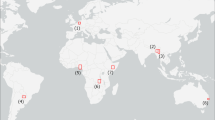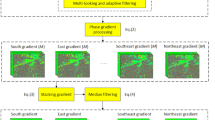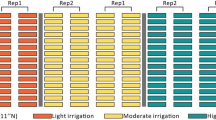Abstract
Rice is one of the most important food crop in India covering about one-fourth of the total cropped area. India is the second largest producer and consumer of rice and accounts for 21% of the world’s total rice production. Rice is fundamentally a kharif season crop and grown in mainly rainfed areas. Recently there is a considerable increase in production, area and yield of rice crop in India. Temporal monitoring of crop area under cultivation is essential for the sustainable management of agricultural activities on both national and global levels. The present study is envisaged to estimate area under kharif rice using multi-temporal Sentinel-1 Synthetic Aperture Radar (SAR) data with dual polarization (VH and VV) in Bhandara district of Maharashtra. The geographical area of Bhandara district is 4087 square kilometres and lies in between 20°64′03′' to 21°60′18′' N latitude and 79°44′93′' to 80°08′70′' E longitude. The rice area is extracted using Random Forest (RF) classification techniques available in SNAP tool and validated using the ground observation collected from the field. An area of 1760 square kilometres was found under kharif rice out of 4087 square kilometres area of entire Bhandara district. The rice is predominant crop and covered around 43% of the total geographical area of Bhandara district during kharif season. The user accuracy (omission error), producer accuracy (commission error) for rice crop, overall accuracy and Kappa coefficients were 82.7, 90.0, 91% and 0.80, respectively. The study found that SAR data can be successfully used for acreage estimation with RF classifier.







Similar content being viewed by others
References
Bhatt, C. K., & Nain, A. S. (2018). Rice acreage estimation using Sentinel-1A dual polarised SAR data in Udham Singh Nagar (Uttarakhand). International Journal of Current Microbiology and Applied Sciences. https://doi.org/10.20546/ijcmas.2018.704.295.
Joshi, M. (2018). Text book of field crops. New Delhi: PHI Learning Private Limited.
Department of Agriculture, Government of Maharashtra. http://krishi.maharashtra.gov.in/Site/Upload/Pdf/Final_advance_est_2018-19.pdf. Accessed 22 September 2020.
Raman, M. G., Kaliaperumal, R., Pazhanivelan, S., & Kannan, B. (2019). Rice area estimation using parameterized classification of Sentinel 1A SAR data. International Archives of the Photogrammetry & Remote Sensing & Spatial Information Scienceshttps://doi.org/10.5194/isprs-archives-XLII-3-W6-141-2019.
Mani, J. K., & Varghese, A. O. (2018). Remote sensing and GIS in agriculture and forest resource monitoring. In G. P. Obi Reddy & S. K. Singh (Eds.), Geospatial Technologies in Land Resources Mapping, Monitoring and Management (pp. 377–400). Switzerland: Springer Nature.
Varghese, A. O., Suryavanshi, A., & Joshi, A. K. (2016). Analysis of different polarimetric target decomposition methods in forest density classification using C band SAR data. International Journal of Remote Sensing. https://doi.org/10.1080/01431161.2015.1136448.
Varghese, A. O., & Joshi, A. K. (2015). Polarimetric classification of C-band SAR data for forest density characterization. Current Science, 108(1), 100–106.
Abdikan, S., Sekertekin, A., Ustunern, M., Sanli, F. B., & Nasirzadehdizaji, R. (2018). Backscatter analysis using multi-temporal Sentinel-1 SAR data for crop growth of maize in Konya basin, Turkey. International Archives of the Photogrammetry & Remote Sensing & Spatial Information Scienceshttps://doi.org/10.5194/isprs-archives-XLII-3-9-2018.
Bazzi, H., Baghdadi, N., Hajj, M. E., Zribi, M., Minh, D. H. T., Ndikumana, E., et al. (2019). Mapping paddy rice using sentinel-1 SAR time series in Camargue. France: Remote Sensing. https://doi.org/10.3390/rs11070887.
Beck, H. E., Zimmermann, N. E., McVicar, T. R., Vergopolan, N., Berg, A., & Wood, E. F. (2018). Present and future Köppen-Geiger climate classification maps at 1-km resolution. Scientific Data. https://doi.org/10.1038/sdata.2018.214.
Wang, X., Ge, X., & Li, X. (2012). Evaluation of filters for Envisat ASAR speckle suppression in pasture area. ISPRS Annals of the Photogrammetry, Remote Sensing and Spatial Information Scienceshttps://doi.org/10.5194/isprsannals-I-7-341-2012.
Yommy, A. S., Liu, R., & Wu, A. S. (2015). SAR image despeckling using refined lee filter. IEEE Xplore. https://doi.org/10.1109/IHMSC.2015.236.
Breiman, L. (2001). Random forests. Machine Learning. https://doi.org/10.1023/A:1010933404324.
Le Maire, G., Marsden, C., Nouvellon, Y., Grinand, C., Hakamada, R., Stape, J. L., & Laclau, J. P. (2011). MODIS NDVI time-series allow the monitoring of Eucalyptus plantation biomass. Remote Sensing of Environment. https://doi.org/10.1016/j.rse.2011.05.017.
Mutanga, O., Adam, E., & Cho, M. A. (2012). High density biomass estimation for wetland vegetation using WorldView-2 imagery and random forest regression algorithm. International Journal of Applied Earth Observation and Geoinformation. https://doi.org/10.1016/j.jag.2012.03.012.
Adam, E., Mutanga, O., Odindi, J., & Abdel-Rahman, E. M. (2014). Land-use/cover classification in a heterogeneous coastal landscape using RapidEye imagery: Evaluating the performance of random forest and support vector machines classifiers. International Journal of Remote Sensing. https://doi.org/10.1080/01431161.2014.903435.
Coulston, J. W., Moisen, G. G., Wilson, B. T., Finco, M. V., Cohen, W. B., & Brewer, C. K. (2012). Modeling percent tree canopy cover: a pilot study. Photogrammetric Engineering & Remote Sensing. https://doi.org/10.14358/PERS.78.7.715.
Gessner, U., Machwitz, M., Conrad, C., & Dech, S. (2013). Estimating the fractional cover of growth forms and bare surface in savannas. A multi-resolution approach based on regression tree ensembles. Remote Sensing of Environment. https://doi.org/10.1016/j.rse.2012.10.026.
Vuolo, F., & Atzberger, C. (2014). Improving Land Cover Maps in Areas of Disagreement of Existing Products using NDVI Time Series of MODIS-Example for Europe Verbesserung von Landbedeckungskarten in GebietenwidersprüchlicherGrundlagenmitHilfe der NDVI-Zeitreihe von MODIS-Beispielfür Europa. Photogrammetrie-Fernerkundung-Geoinformation. https://doi.org/10.1127/1432-8364/2014/0232.
Li, H., Leung, K. S., Wong, M. H., & Ballester, P. J. (2014). Substituting random forest for multiple linear regression improves binding affinity prediction of scoring functions: Cyscore as a case study. BMC Bioinformatics. https://doi.org/10.1186/1471-2105-15-291.
Verrelst, J., Rivera, J. P., Veroustraete, F., Muñoz-Marí, J., Clevers, J. G. P. W., Camps-Valls, G., & Moreno, J. (2015). Experimental Sentinel-2 LAI estimation using parametric, non-parametric and physical retrieval methods-A comparison. ISPRS Journal of Photogrammetry and Remote Sensing. https://doi.org/10.1016/j.isprsjprs.2015.04.013.
Dave, R., Haldar, D., Manjunath, K., Dave, V., Chakraborty, M., & Pandey, V. (2019). Identification of cotton crop in Gujarat using multi date RISAT-1 SAR data. Journal of Agrometeorology, 21((Special issue-“NASA 2014” part-III)), 1–6.
McNairn, H., Champagne, C., Shang, J., Holmstrom, D., & Reichert, G. (2009). Integration of optical and synthetic aperture radar (SAR) imagery for delivering operational annual crop inventories. ISPRS Journal of Photogrammetry & Remote Sensing. https://doi.org/10.1016/j.isprsjprs.2008.07.006.
Wang, C. Z., Wu, J. P., Zhang, Y., Pan, G. D., Qi, J. G., & Salas, W. A. (2009). Characterizing L-band scattering of paddy rice in Southeast China with radiative transfer model and multitemporal ALOS/PALSAR imagery. IEEE Transactions on Geoscience and Remote Sensing. https://doi.org/10.1109/TGRS.2008.2008309.
Dong, Y., Sun, G., & Pang, Y. (2006). Monitoring of rice crop using ENVISAT ASAR data. Science in China Series D. https://doi.org/10.1007/s11430-006-0755-0.
Jia, M., Tong, L., Zhang, Y., & Chen, Y. (2013). Multitemporal radar back scattering measurement of wheat fields using multifrequency (L, S, C and X) and full-polarization. Radio Science. https://doi.org/10.1002/rds.20048.
Tan, L., Chen, Y., Jia, M., Tong, L., Li, X., & He, L. (2015). Rice biomass retrieval from advanced synthetic aperture radar image based on radar backscattering measurement. Journal of Applied Remote Sensing. https://doi.org/10.1117/1.JRS.9.097091.
He, Z., Li, S., Wang, Y., Dai, L., & Lin, S. (2018). Monitoring rice phenology based on backscattering characteristics of multi-temporal RADARSAT-2 datasets. Remote Sensing. https://doi.org/10.3390/rs10020340.
FAO. (2018). Rice Market Monitor. Volume XXI(I). Available online: http://www.fao.org/3/I9243EN/i9243en.pdf. Accessed 23 September 2020.
Nguyen, D. B., Gruber, A., & Wagner, W. (2016). Mapping rice extent and cropping scheme in the Mekong Delta using Sentinel-1A data. Remote Sensing Letters. https://doi.org/10.1080/2150704X.2016.1225172.
Ranjan, A. K., & Parida, B. R. (2019). Paddy acreage mapping and yield prediction using sentinel—based optical and SAR data in Sahibganj district. Jharkhand (India): Spatial Information Research. https://doi.org/10.1007/s41324-019-00246-4.
Onojeghuo, A. O., Blackburn, G. A., Wang, Q., Atkinson, P. M., Kindred, D., & Miao, Y. (2018). Mapping paddy rice fields by applying machine learning algorithms to multi-temporal Sentinel-1A and Landsat data. International Journal of Remote Sensing. https://doi.org/10.1080/01431161.2017.1395969.
Son, N.-T., Chen, C.-F., Chen, C.-R., & Minh, V.-Q. (2017). Assessment of Sentinel-1A data for rice crop classification using random forests and support vector machines. Geocarto International. https://doi.org/10.1080/10106049.2017.1289555.
Acknowledgement
Authors extend their sincere gratitude to Regional Remote Sensing Centre-Central, National Remote Sensing Centre (NRSC), Indian Space Research Organisation (ISRO) and Jawaharlal Nehru Technological University Kakinada for providing opportunity and facility to conduct the study. The technical support provided by RRSC-Central staff is duly acknowledged. We are also thankful to Sentinel Copernicus Science Hub maintained by the European Space Agency (ESA) for online accessibility of Sentinel-1 SAR data. Authors are also thankful to the anonymous reviewers.
Funding
Not applicable.
Author information
Authors and Affiliations
Contributions
Nandepu.V. V. S. S. Teja Subbarao, Jugal Kishore Mani and A. O. Varghese formulated and designed this research. Nandepu.V. V. S. S. Teja Subbarao, Jugal Kishore Mani and Ashish Shrivastava carried out the data processing and analysis. Nandepu.V. V. S. S. Teja Subbarao and K. Srinivas wrote the paper. A. O. Varghese provided suggestions and modified the paper. Nandepu.V. V. S. S. Teja Subbarao, Jugal Kishore Mani and A. O. Varghese revised the manuscript draft.
Corresponding author
Ethics declarations
Conflicts of interest
On behalf of all authors, the corresponding author states that there is no conflict of interest.
Additional information
Publisher's Note
Springer Nature remains neutral with regard to jurisdictional claims in published maps and institutional affiliations.
Rights and permissions
About this article
Cite this article
Subbarao, N.V.V.S.S.T., Mani, J.K., Shrivastava, A. et al. Acreage estimation of kharif rice crop using Sentinel-1 temporal SAR data. Spat. Inf. Res. 29, 495–505 (2021). https://doi.org/10.1007/s41324-020-00374-2
Received:
Revised:
Accepted:
Published:
Issue Date:
DOI: https://doi.org/10.1007/s41324-020-00374-2




